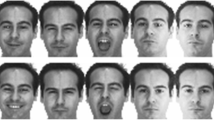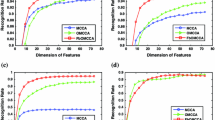Abstract
Due to the noise disturbance and limited number of training samples, within-set and between-set sample covariance matrices in canonical correlations analysis (CCA) based methods usually deviate from the true ones. In this paper, we re-estimate the covariance matrices by embedding fractional order and incorporate the class label information. First, we illustrate the effectiveness of the fractional-order embedding model through theory analysis and experiments. Then, we quote fractional-order within-set and between-set scatter matrices, which can significantly reduce the deviation of sample covariance matrices. Finally, we incorporate the supervised information, novel generalized CCA and discriminative CCA are presented for multi-view dimensionality reduction and recognition, called fractional-order embedding generalized canonical correlations analysis and fractional-order embedding discriminative canonical correlations analysis. Extensive experimental results on various handwritten numeral, face and object recognition problems show that the proposed methods are very effective and obviously outperform the existing methods in terms of classification accuracy.












Similar content being viewed by others
References
Jolliffe IT (1986) Principle components analysis. Springer, New York
Truk M, Pentland A (1991) Eigenfaces for recognition. J Cogn Neurosci 3(1):71–86
Fisher RA (1936) The use of multiple measurements in taxonomic problems. Ann Eugen 7:178–188
Belhumeur PN, Hespanha JP, Kriegman DJ (1997) Eigenfaces vs. fisherfaces: recognition using class specific linear projection. IEEE Trans Pattern Anal Mach Intell 19(7):711–720
Tenenbaum JB, Silva V, Langford JC (2000) A global geometric framework for nonlinear dimensionality reduction. Science 290(5500):2319–1323
Roweis ST, Saul LK (2000) Nonlinear dimensionality reduction by locally linear embedding. Science 290(5500):2323–2326
Belkin M, Niyogi P (2003) Laplacian eigenmaps for dimensionality reduction and data representation. Neural Comput 15(6):1373–1396
Zhang Z, Zha H (2004) Principal manifolds and nonlinear dimension reduction via local tangent space alignment. SIAM J Sci Comput 26(1):313–338
Hou C, Wang J, Yi W, Yi D (2009) Locally linear transformation embedding. Neurocomputing 72(10–12):2368–2378
Sargin M, Yemez Y, Erzin E, Tekalp A (2007) Audio-visual synchronization and fusion using canonical correlation analysis. IEEE Trans Multimedia 9(7):1396–1403
Slaney M, Covell M (2000) FaceSync: a linear operator for measuring synchronization of video facial images and audio tracks. In: Leen TK, Dietterich TG, Tresp V (eds) Advances in neural information processing systems (NIPS), vol 13. MIT Press, Cambridge, pp 814–820
Chibelushi CC, Deravi F, Mason JSD (2002) A review of speech-based bimodal recognition. IEEE Trans Multimedia 4(1):23–37
Jain AK, Duin RPW, Mao J (2000) Statistical pattern recognition: a review. IEEE Trans Pattern Anal Mach Intell 22(1):4–37
Hou C, Zhang C, Wu Y, Nie F (2010) Multiple view semi-supervised dimensionality reduction. Pattern Recognit 43(3):720–730
Hotelling H (1936) Relations between two sets of variates. Biometrika 28(3/4):321–377
Sun QS, Zeng SG, Liu Y, Heng PA, Xia DS (2005) A new method of feature fusion and its application in image recognition. Pattern Recognit 38(12):2437–2448
Sun QS, Zeng SG, Wang PA, Xia DS (2005) The theory of canonical correlation analysis with its applications to feature fusion. Chin J Comput 28(9):1524–1533
Hardoon DR, Szedmak SR, Shawe-Taylor JR (2004) Canonical correlation analysis: an overview with application to learning methods. Neural Comput 16(12):2639–2664
Sun Q-S, Liu Z-D, Heng P-A, Xia D-S (2005) A theorem on the generalized canonical projective vectors. Pattern Recognit 38(3):449–452
Sun TK, Chen SC, Yang JY, Shi PF (2008) A novel method of combined feature extraction for recognition. In: IEEE international conference on data mining, Pisa, Italy, pp 1043–1048
Yuan Y-H, Sun Q-S, Ge H-W (2014) Fractional-order embedding canonical correlation analysis and its applications to multi-view dimensionality reduction and recognition. Pattern Recognit 47:1411–1424
Yuan Y-H, Sun Q-S (2013) Fractional-order embedding multiset canonical correlations with applications to multi-feature fusion and recognition. Neurocomputing 122:229–238
Golub GH, Van Loan CF (1996) Matrix computations, vol 47(5 Series II). The Johns Hopkins University Press, Baltimore, pp 392–396
Liu J, Chen S-C, Tan X-Y (2008) Fractional order singular value decomposition representation for face recognition. Pattern Recognit 41:378–395
Martinez AM, Benavente R (1998) The AR face database. CVC Technical Report #24, June 1998
Georghiades A, Belhumeur P, Kriegman D (2001) From few to many: illumination cone models for face recognition under variable lighting and pose. IEEE Trans Pattern Anal Mach Intell 23(6):643–660
Lee K, Ho J, Kriegman D (2005) Acquiring linear subspaces for face recognition under variable lighting. IEEE Trans Pattern Anal Mach Intell 27(5):684–698
Fu Y, Yan S, Huang TS (2008) Correlation metric for generalized feature extraction. IEEE Trans Pattern Anal Mach Intell 30(12):2229–2235
Yan S, Xu D, Zhang B, Zhang H, Yang Q, Lin S (2007) Graph embedding and extensions: a general framework for dimensionality reduction. IEEE Trans Pattern Anal Mach Intell 29(1):40–51
He X, Ji M, Zhang C, Bao H (2011) A variance minimization criterion to feature selection using Laplacian regularization. IEEE Trans Pattern Anal Mach Intell 33(10):2013–2025
Nene SA, Nayar SK, Murase H (1996) Columbia object image library (COIL-20). Technical Report CUCS-005-96
Warfield S (1996) Fast k-NN classification for multichannel image data. Pattern Recognit Lett 17(7):713–721
Barlaud M, Mathieu P, Daubechies I (1990) The wavelet transform, time-frequency localization and signal analysis. IEEE Trans Inf Theory 36(5):961–1005
Dai D-Q, Yuen PC (2007) Face recognition by regularized discriminant analysis. IEEE Trans Syst Man Cybern Part B Cybern 37(4):1080–1085
Ji S, Ye J (2008) Kernel uncorrelated and regularized discriminant analysis: a theoretical and computational study. IEEE Trans Knowl Data Eng 20(10):1311–1321
Acknowledgments
This work is supported in part by Graduate Research and Innovation Foundation of Jiangsu Province, China, under Grant KYLX15_0379, and in part by the National Natural Science Foundation of China under Grants 61273251, 61401209, and 61402203.
Author information
Authors and Affiliations
Corresponding author
Rights and permissions
About this article
Cite this article
Ji, HK., Sun, QS., Yuan, YH. et al. Fractional-Order Embedding Supervised Canonical Correlations Analysis with Applications to Feature Extraction and Recognition. Neural Process Lett 45, 279–297 (2017). https://doi.org/10.1007/s11063-016-9524-z
Published:
Issue Date:
DOI: https://doi.org/10.1007/s11063-016-9524-z




